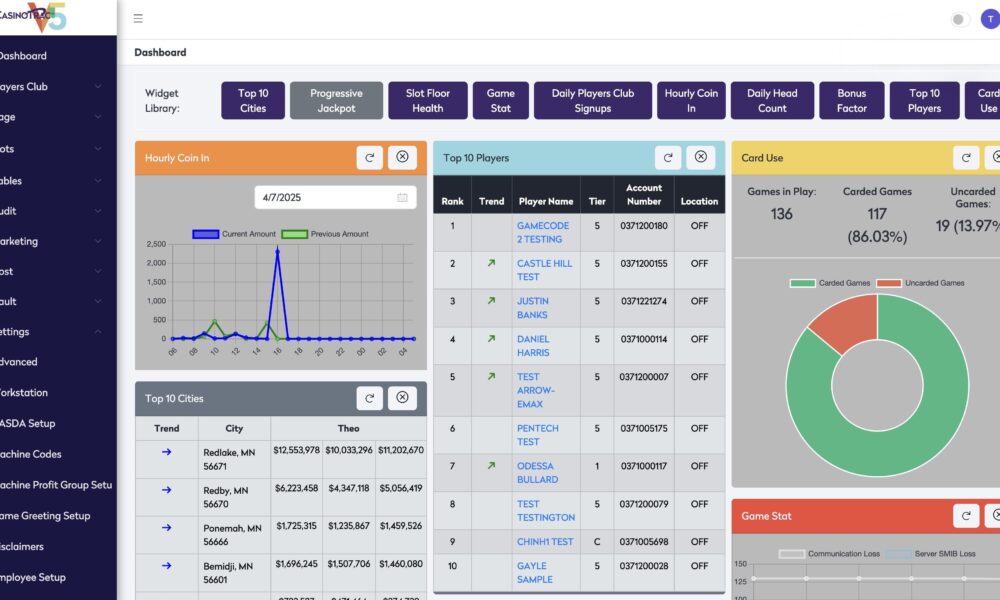CasinoTrac has come a long way in 30 years since it first introduced its casino management system, and company founder and president Chad Hoehne continues to lead that journey by introducing the next generation of technology for the industry.
At G2E, CasinoTrac showcased V5, its fifth version of their CMS with a secure React-based user interface and fully MCP-capable API for integration with artificial intelligence. It’s currently in lab testing, and the first casino installations are expected by the first half of 2026.
“This was designed after exhaustive interviews with existing customers,” Hoehne said. “It is important to users in every single department we serve.”
Given that it is their 30th anniversary of doing systems in casinos, Hoehne has been strolling through the memory lane of their history and how they arrived at V5 today.
It started in 1995 with the TableTrac Keypad prototype that he started introducing to casinos to track the cash on their tables during game play.
“That spawned the idea of TableTrac in its first days,” he explained. “By 1996 we had these units in production and were putting them in table games in the Midwest primarily and would track the seat positions of the players, the player cards and the money. The dealers would swipe, and the supervisors would swipe on the keypad. We tracked when a new dealer came to the table and when a new supervisor came. We tracked the drop going into the game and the players.”
By 2003, they had expanded to their CasinoTrac casino management system by adding slot machine interface boards going to games.
“CasinoTrac was born by combining TableTrac with table games management system, player loyalty, and promotions administration system coupled with the slot floor online system all under one roof,” Hoehne said.
Back then, they chose a new technology for their user interface – CasinoTrac’s Version 3 operated as a web-based interface instead of going to client servers. It was the first CMS to adopt this cutting-edge, web-based browser interface at the time.
“Web-based interfaces were very new at the time,” Hoehne said. “We made a wise choice as it turns out because that’s where everyone else is going today if they haven’t already gone there.”
By 2004, CasinoTrac had designed a slot interface board which also featured a keypad and card reader. What was unique about the setup was that it was ethernet-based, a new and efficient system for gaming floor communications at the time.
In 2012, CasinoTrac had advanced to its V4 system with modern touchscreen displays with slot machine interface boards and an API-based web service user interface.
“It’s pretty much the setup you see today on most gaming floors,” said Hoehne.
All of these evolutions eventually led to the development of V5.
“What makes it exciting for our customers and prospects is that the user interface has been converted over to a secure, React-based front end,” he said. “React is the next generation of the web-based interface. What is most important is that behind this interface is a full set of API to feed the data. There’s no more CGI technology. It’s all web-based API technology. In order for AI to connect to your application or connect to your gaming floor system directly, you need an API integration. That’s how AI is going to talk between different systems to link them together, pull data and give answers about your own gaming floor in your own building when you ask it a question.”
“If you ask an AI what part of the casino floor is running slow, the AI through MCP talks to the system and looks at the floor and tells which part of the floor that is,” Hoehne said. MCP stands for Model Context Protocol, an open-source standard that allows AI systems to securely and consistently connect to other software, tools, and platforms. It enables AI agents to have a shared, persistent context, allowing them to coordinate tasks across different applications and remember information over time, rather than operating in isolated silos.
“The game-changing aspect of it is that it is compatible with MCP so that it comes out of the box ready to talk to any one of the different AI systems that are being explored in the marketplace,” explained Hoehne. “We’re not locked into any particular AI. We’re making it available for all AIs to interact with.”
Because it interfaces with AI, Hoehne pointed out that operators can start to rely on AI to put up guardrails around settings to prevent staff from doing anything incorrectly, like skipping a step or when they are doing a task.
“Ultimately, it would provide the ability for AI to operate the system,” he said.
“Additionally, the new user interface is more graphically formative and simpler to navigate,” Hoehne said. It only provides the information that a particular user is enabled to see, he added.
“It’s all been a remarkable journey,” Hoehne said of the history of the company in the casino management system space. “The part that’s been so intriguing to me is learning about, developing and deploying leading-edge technologies in the casino systems’ space for all of these years. Being on the forefront of them has been exciting and satisfying for me and I really enjoy going in and making something new work for our industry.”

